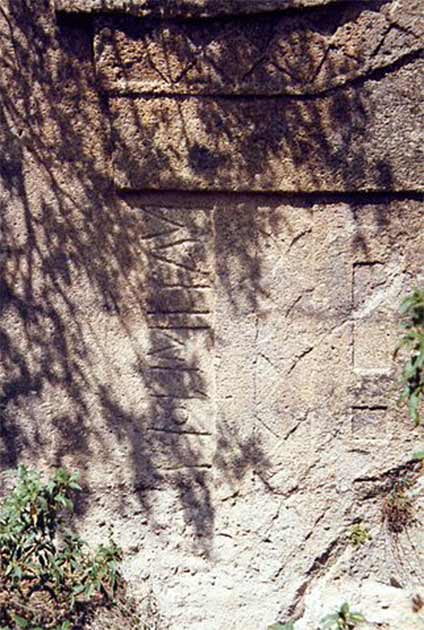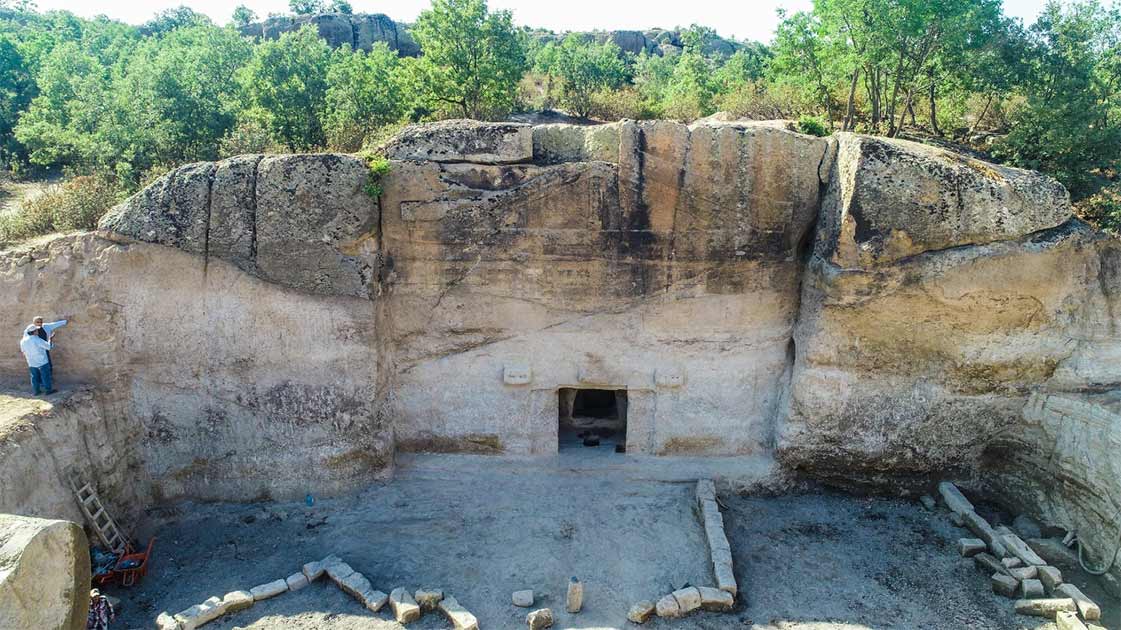Phrygian Temple Found Beneath the Famous Maltas Monument in Turkey
For almost 100 years archaeologists in Turkey thought they knew everything about the famous 7th-century-BC Maltaş monument. That just changed, after a 40-day emergency excavation revealed the rock-cut sacred site is three times deeper and that sat on top of an ancient Phrygian temple.
The famous Maltaş monument is one of the most visually impressive archaeological features in the Ihsaniye district’s Phrygian Valley, in western Turkey. Afyonkarahisar Governor, Gökmen Çiçek, told Anadolu Agency that this wondrous religious monument of ancient Phrygia, “is an incredible structure built around 3,000 years ago.”
Governor Çiçek said that until now only a 3-meter-long section of the Maltaş monument was visible above ground. The Governor explained that the recent team of excavators reached the new “7-meter underground section” during a 40-day rescue excavation. According to Daily Sabah the governor said the team of archaeologists set out to save the monument, and that they certainly were not expecting to come across what he called “an enormous artifact.”

Until just recently the Maltas monument in Turkey looked like this and no one suspected what lay beneath the surface. The newly discovered Phrygian temple below the monument will shed more light on the spiritual beliefs of the Phrygians. (Klaus-Peter Simon / CC BY 3.0)
The Newly Discovered Phrygian Temple And What It Reveals
Before we look closer at what this newly discovered aspect of the famous sacred site actually represents, or means, if you’re anything like me the first step is to answer the question: who were the Phrygians? Known as a “Trak tribe” from “Thrace” in southeastern Europe (now Bulgaria, Greece, and Turkey,) the Phrygian people began migrating to ancient Anatolia (now Turkey) from 1200 BC.
- The Ancient Kingdom of Tuwana: A Bridge that Aided the Flow of Culture
- The Anatolian Histories Part 1: Emerging Empires and Lands Changing Hands
According to Anthony Pagden’s 2002 paper, Europe: Conceptualizing a Continent, the Phrygians settled along the shores of Askania Lake (Iznik Lake), in the Sangarius River Valley (Sakarya River Valley), and deeper into central Anatolia where they established a powerful dual state between the 9th and 6th centuries BC.
They constructed their most sacred spaces and cult centers in high lands overlooking the planes. There, on dry mounds and rises, relatively safe from inward attack, Phrygians believed the Goddess Kybele (Cybele) resided in the actual rocks.

Seated Woman of Çatalhöyük circa 6,000 BC who was the inspiration for the Phrygian Cybele goddess. This same goddess, known as the mother of all gods was also popular in classical Greece and Rome. (Nevit Dilmen / CC BY-SA 3.0)
Reliving The Phrygian Temple Goddess From Her Stone Cage
Cybele was the ancient primal nature goddess and the Phrygian mother of all gods. This supreme deity was worshipped with orgiastic sex-rites at rock-cut sites like these, hidden deep within the mountains of central and western Anatolia.
A UNESCO tentative list entry explains that Phrygians believed their goddess manifested “in bare cliffs, valleys and mountains near to freshwater bodies.” Therefore, what has been discovered, is 7 more meters of carved out rock, which was undertaken to honor of the “rock” goddess Cybele.
In 1881, W. M. Ramsay, first discovered the 7th-century-BC Maltaş monument, which he described as “a temple facade with a triangular roof.” Now it is known that site is but one of hundreds that encrust the region’s deep valleys alongside castles, burial mounds and ancient necropolises. An article in Arkeonews explains that excavations in 1936, 1950 and 1970 all removed dirt from the front of the temple.
Unfortunately, when these good-willed archaeologists ended their digs they threw in tons of infill soil attempting to preserve the monument from further water erosion. Nevertheless, underground water channels have now “worn out the subterranean portions,” according to Governor Çiçek. It was to save these underground aspects of the monument that the emergency 40-day dig was carried out.

Archaeologists working in the area of the Maltaş monument, Phrygian Valley, Afyonkarahisar, western Turkey, Aug. 7, 2021. (AA Photo) (Anadolu Agency)
Utterances To Goddesses, And Kings Of Course
Two inscriptions have been discovered at the site. One was found on outside border, surrounding the façade wall, and the other was inscribed on the upper frame of a niche. While the top of the former inscription is a dedication to the legendary 7th-century-BC King Midas, the second honors the goddess. The governor added that while most of the carved features have now been interpreted, the purpose of a “newly uncovered niche deep inside the monument” has yet to be determined.
- The Mother of all Gods: The Phrygian Cybele
- The Mysterious Midas City: 2,800-Year-Old City with Monumental Facades and Strange Inscriptions

A Phrygian cult facade near Afyon, Turkey, featuring an inscription in the Phrygian script. Other Phrygian inscriptions have been found near the Maltas Monument that mention their famous king: King Midas. (Klaus-Peter Simon / CC BY 3.0)
What is known about the mysterious niche, according to Lynn E. Roller’s 1999 book In Search of God the Mother: The Cult of Anatolian Cybele, is, “the niche was the goddess,” as were cups, bowls and other indented, or vaginal-shaped ritual items.
Having developed a deep-religious and sexualized culture, the Phrygian state collapsed in the early 7th century BC after nomadic Cimmerians sacked all of Anatolia. However, all was not lost, as many fertile members of the Phrygian royal family escaped the Cimmerian attacks and went on to seed their ancient culture in various parts of ancient Anatolia, according to the UNESCO tentative list entry on the Maltas monument.
Top image: A rare Phrygian temple was found to lie beneath the famous Maltas monument in Turkey and more will surely be found in the subterranean levels of the site. Source: Anadolu Agency
By Ashley Cowie



















